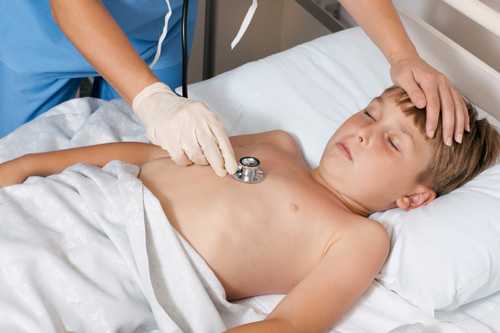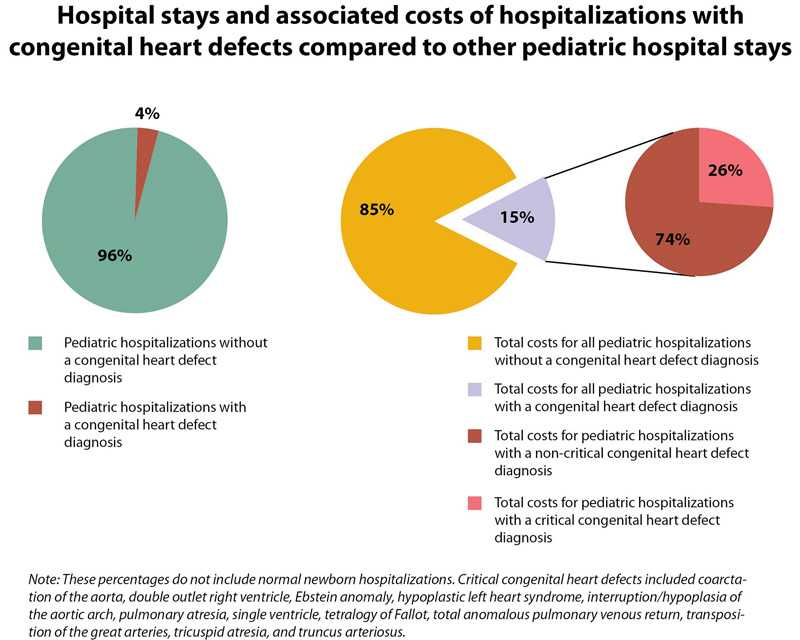Key Findings: Hospital Costs and Resource Use for Children and Adolescents with Congenital Heart Defects

In a recent study, CDC researchers found that in 2009, hospitalized U.S. children and adolescents who had a congenital heart defect (CHD) had more expensive hospital stays than those who were hospitalized without a CHD. The most expensive hospital stays were for infants, children, and adolescents with critical congenital heart defects (CCHD). This information might help improve public health practices and healthcare planning to adequately serve people of all ages with a CHD. You can read the abstract of the article here.
Main Findings from this Study
- Hospitalizations of patients with a CHD made up 3.7% of all hospitalizations in the United States for children and adolescents aged 0-20 years.
- Hospital costs for patients with a CHD exceeded $5.6 billion in 2009. Although patients with a CHD comprised only 3.7% of the hospitalizations, the costs were 15.1% of the total costs for all U.S. hospitalizations for children and adolescents aged 0-20 years.
- 26.7% of the costs for children and adolescents with a CHD were from hospitalizations of patients with a CCHD diagnosis.
- Hospital costs were highest if:
- The patient was less than a year old;
- The patient had a CCHD (as compared to other types of CHDs);
- The patient died while in the hospital.
- Hospital costs were highest for patients with these CCHDs: hypoplastic left heart syndrome, coarctation of the aorta, and tetralogy of Fallot.
- Although babies less than one year old with a CHD had the highest costs, the costs of hospitalizations due to a CHD were still very high across all ages: the average cost per hospitalization among patients 1-20 years old was $25,000.

About this Study
About Congenital Heart Defects (CHDs)
- CHDs are the most common type of birth defect, affecting nearly 1% of all babies born in the United States1.
- About 25% of these babies have a type of CHD called a critical congenital heart defect (CCHD)2, 3.
- Improvements in detection and treatment have allowed many babies born with a CHD to live longer lives and many are expected to live well into adulthood4-6.
- Although improvements in detection and treatment have allowed many babies born with a CHD to live longer lives4-6, little is known about the healthcare needs of children and adolescents with CHDs or the impact of this population on hospital resource use and the resulting costs that the hospitals experience.
- The researchers that conducted this study used the 2009 Kids’ Inpatient Database (KID), which is maintained by the Agency for Healthcare Research and Quality’s (AHRQ) Healthcare Cost and Utilization Project (HCUP)7, 8. Data from forty-four states were included in this analysis, which gives us a better picture of hospital resource use across all of the United States.
- The researchers included hospital discharges (medical records completed after a hospital stay) that occurred between January 1 and December 31, 2009, of patients up to 20 years old when they came to the hospital.
- All of these patients were diagnosed with at least one CHD. Researchers grouped the patients into those with a CCHD, and those with a non-critical CHD.
- The patients were also grouped by age (less than a year old, 1-10 years old, and 11-20 years old).
- The researchers compared the average hospital costs for patients with a CHD and patients without a CHD (not including normal newborns who were simply born in the hospital). They further compared hospital costs for patients with a CCHD and patients with a non-critical CHD. Hospital costs are different than what a health insurance company or person sees on a bill. Hospital costs are how much it costs the hospital to provide services (for example – how much it costs to pay staff, run tests, give medicine, or perform surgery).
Health Services Related to Congenital Heart Defects: CDC’s Activities
CDC’s National Center on Birth Defects and Developmental Disabilities (NCBDDD) is committed to learning more about health service use and costs associated with having a CHD. CDC also works to identify causes and prevention opportunities for CHDs by applying a comprehensive public health approach.
- Surveillance or disease tracking:
- State programs: CDC currently works with state tracking programs to identify which states have health service use data. This helps CDC examine many topics, including costs, hospital resource use, access and referral to services, and health outcomes beyond infancy. CDC also funds 14 population-based state tracking programs. Birth defects tracking systems are vital to help CDC find out where and when infants with birth defects, including CHDs, are born and who is affected.
- Adolescents and adults: CDC recently started 3 projects to track adolescents and adults with CHD in order to learn about their health issues and needs across the lifespan that come from being born with a heart defect.
- Research: CDC works with several different state tracking systems to research costs associated with having birth defects, including CHDs. By looking at different sources, CDC can get a more complete picture of the actual costs related to having birth defects.
- Prevention: By studying the occurrence of CHDs among the population, there is the potential to identify factors that put a woman at risk for having a baby with a CHD. Such new information could be translated into strategies to prevent CHDs.
- Collaboration: CDC provides technical assistance to the Congenital Heart Public Health Consortium, a unique collaboration that brings together families, experts, and organizations to prevent CHDs and improve outcomes for affected children and adults.
More Information
To learn more about congenital heart defects, please visit https://www.cdc.gov/ncbddd/heartdefects/.
Reference for Key Findings
Simeone RM, Oster ME, Cassell CH, Armour BS, Gray DT, Honein MA. Pediatric inpatient hospital resource use for congenital heart defects. Birth Defects Research Part A: 2014. [epub ahead of date].
References
- Reller MD, Strickland MJ, Riehle-Colarusso T, Mahle WT, Correa A. Prevalence of congenital heart defects in metropolitan Atlanta, 1998-2005. Journal of Pediatrics. 2008;153:807-13.
- Botto LD, Correa A, Erickson JD. Racial and temporal variations in the prevalence of heart defects. Pediatrics. 2001;107:E32.
- Mahle WT, Newburger JW, Matherne GP, Smith FC, Hoke TR, Koppel R, Gidding SS, Beekman RH 3rd, Grosse SD. Role of pulse oximetry in examining newborns for congenital heart disease: a scientific statement from the AHA and APA. Circulation. 2009;120:447-58.
- Oster M, Lee KA, Honein MA, Colorusso T, Shin M, Correa A. Temporal trends in survival among infants with critical congenital heart defects. Pediatrics. 2013;131:e1502-e8.
- Williams RG, Pearson GD, Barst RJ, Child JS, del Nido P, Gersony WM, Kuehl KS, Landzberg MJ, Myerson M, Neish SR, Sahn DJ, Verstappen A, Warnes CA, Webb CL. Report of the National Heart, Lung, and Blood Institute Working Group on research in adult congenital heart disease. Journal of the American College of Cardiology. 2006;47:701-7.
- Marelli AJ, Mackie AS, Ionescu-Ittu R, Rahme E, Pilote L. Congenital heart disease in the general population: changing prevalence and age distribution. Circulation. 2007;115:163-72.
- Agency for Healthcare Research and Quality. HCUP Kids’ Inpatient Database (KID). Healthcare Cost and Utilization Project (HCUP). 2009. Available at http://www.hcup-us.ahrq.gov/kidoverview.jsp. Accessed March 8, 2014.
- Agency for Healthcare Research and Quality. Introduction to the HCUP KIDS’ Inpatient Database (KID) 2009. 2011. Available at http://www.hcup-us.ahrq.gov/db/nation/kid/KID_2009_Introduction.pdf. Accessed March 8, 2014.
- Page last reviewed: July 9, 2014
- Page last updated: November 8, 2016
- Content source:


 ShareCompartir
ShareCompartir